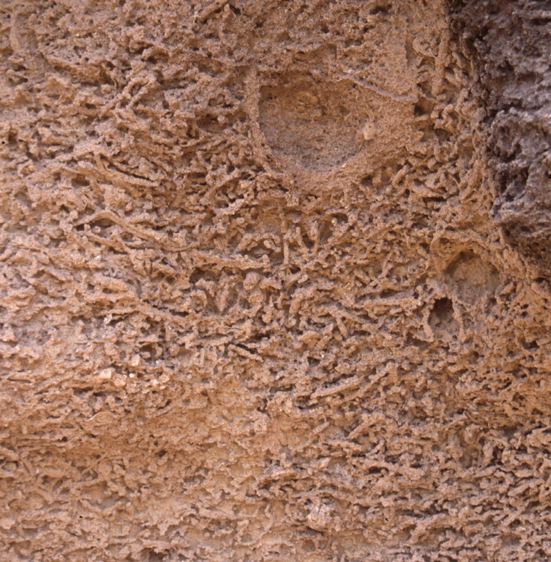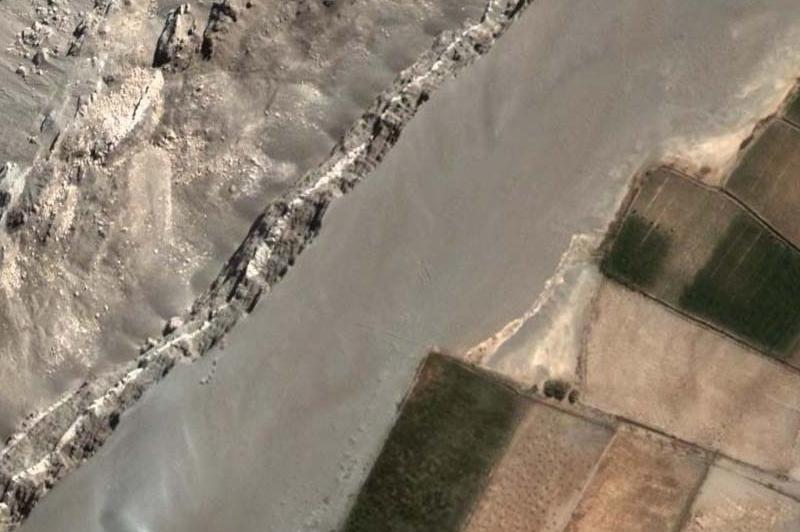The Salt Predicament
Is sustainable irrigation possible?
TAKE 1
It is difficult to manage the salts produced by irrigation, as shown by
current experience in the San Joaquin river and Tulare Lake basins in California.
In order to manage salts properly,
we must first recognize their various types.
We must also have a knowledge of their sources, transport, and fate.
A salt
is a chemical compound formed by a positively charged cation and a negatively charged anion.
1. Irrigation and salts

|
Fig. 1 Sodium chloride molecule (Clark Earley,
Kent State University)
The salt cations are sodium, calcium, magnesium, and potassium.
Typical salt anions are chloride, sulfate, and carbonate.
The source of all salts is geologic, originating in the parent rocks.
Weathering and bioturbation disaggregate the rocks and release soil particles containing salts in their matrix and on their surfaces.

|
Fig. 2 Bioturbation (Carlo Messina,
University of Catania, Italy)
Transport by surface and subsurface runoff releases some of these salts to the water, where they remain in solution until used.

|
Fig. 3 Calcium-carbonate-saturated spring
in Hierve el Agua, Oaxaca, Mexico.
TAKE 2
2. Salts and plants
Plants are selective
in their use of salts.
Salts of potassium and magnesium are usually in short supply compared to the demand, while salts of sodium and calcium
tend to accumulate due to their lack of use.
The selectiveness of the biosphere in its use of salts creates a problem of disposal.
What to do with the salts that are not wanted?
For the most part, these salts are conveyed in solution by the hydrosphere until
a sink of some kind is reached.
Nature provides for two distinct salt sinks:

|
Fig. 4 The Dead Sea, or Salt Sea, between Israel,
the West Bank, and Jordan (photobucket.com).
The ocean precipitates or uses most of the incoming salts, except notably sodium chloride.
Thus, close to 86% of the dissolved salt ions in ocean waters are sodium and chloride.

| 
|
Fig. 5 Dissolution of salt in water (Charles E. Ophardt,
Elmhurst College).
Inland salt lakes feature a wide range of salts, although sodium chloride appears to predominate.
Close to 60% of the salt ions in the Salton Sea, in California, an inland repository of agricultural drainage, are sodium and chloride.

|
Fig. 6 The Salton Sea, in Imperial and
Riverside counties, California.
TAKE 3
3. Good and bad salts
The biosphere uses the good salts: potassium and magnesium.
It wastes the bad salts: sodium and calcium.
The problem is compounded by the fact that evapotranspiration concentrates the unwanted salts in the runoff waters.
Thus, headwater streams tend to be low in salt content,
while estuarial rivers tend to be high.
Nature intended for the exorheic basins, usually in the periphery of continents, to be flushed of their salts by surface runoff.
She also intended for the endorheic or closed basins in the central regions of continents to
accumulate salts, and thus, to feature low biodiversity.

|
Fig. 7 Tufa limestone formations exposed in Mono Lake,
Northeastern California.
Since the start of the agricultural revolution, humans have learned to grow crops to sustain their sedentary way of life.
Eventually, humans learned to artificially control the amount of water used in crop production, thus increasing the productivity and socioeconomic impact of agriculture.
Irrigation is lofty, but it carries within itself a hindrance: the production of salt in amounts over and above what Nature had intended.

|
Fig. 8 Salt-affected irrigation field in the Chao valley,
along the northern coast of Peru.
TAKE 4
4. Sources of salt
There are four sources of salt:
- old natural,
- old artificial,
- new natural, and
- new artificial.
| Sources of salt | Natural | Artificial |
| Old | Already present in the soil profile due to endorheism | Present in the irrigation water |
| New | Present in the soil matrix, and released by weathering and bioturbation | Added by fertilization |
Old natural salts are those already present in the soil profile and subsequently leached by the excess irrigation waters.
These salts occur in fully or partially endorheic geologic settings, such as lakes and inland regions with a geologic history of deficient drainage.
They also occur in near-coastal marine environments that have been subjected to uplift.

|
Fig. 9 Aerial view of saline seep along slope of Vitor valley,
near La Cano irrigation, Arequipa, Peru (Google Earth).
Old artificial salts are those present in the irrigation water, which always carries a certain amount of salts.
This amount tends to be small
with fresh surface waters and large in the case of deep groundwaters.
New natural salts are by far the most misunderstood.
Soils are carriers and producers of salt.
The efficient functioning of irrigation releases good and bad salts from the soils.
The good salts are incorporated into the biomass, while the bad salts are wasted.
These salts are dissolved in the waste runoff, eventually flowing into streams and rivers.
The reduction or elimination of waste runoff is counterproductive, because it leads to the accumulation of salts in the soil profile, eventually rendering irrigation unprofitable.
New artificial salts are those added by the irrigation system.
The irrigation system often fertilizes the land by adding a suitable combination of required nutrients, among them, salts of potassium and magnesium.
But too much of a good thing may result in overfertilization and consequent enrichment of the waste runoff.
This nonpoint-source pollution could lead to the eutrophication of neighboring water bodies.
TAKE 5
5. Irrigation engineering
A properly designed irrigation system should minimize old natural salts by carefully choosing the lands to be irrigated to avoid endorheic or partially endorheic drainages, and near-coastal areas of marine origin.
If this is not possible, a salt budget should indicate the extra amount of old natural salts to be mobilized and properly disposed of.
The benefit/cost analysis should include the full cost of proper salt disposal.
The irrigation project should also choose carefully the irrigation waters, to minimize the impact of old artificial salts.
It is poor practice to pump highly saline groundwaters for irrigation and then to accumulate the resulting brackish wastewater in evaporation ponds.

|
Fig. 10 Evaporation pond in Tulare Lake, Central valley, California.
The new natural salts cannot be avoided.
It is the price to pay for the benefits afforded by the additional amount of food and fiber realized by irrigation.

|
Fig. 11 Parallel irrigation and drainage canals,
Wellton-Mohawk, Arizona.
Still, a carefully prepared salt budget should indicate the extra amount of new natural salts to be mobilized and properly disposed of.
As with the old natural salts, the benefit/cost analysis should include the full cost of proper salt disposal.
The new artificial salts can be avoided by proper on-farm fertilizer management.
TAKE 6
6. Salt management
The contemporary issues of irrigation salt management are seen to be very complex and costly.
Is a sustainable solution, which also makes economic sense, possible?
In the case of salt management, it appears that the only sustainable solution, however wasteful in appearance, is to allow the rivers to reassert their natural function of carrying the salts to the ocean, where they can remain, forever, out of sight and out of mind.
This entails reserving a certain fraction of the runoff for this intrinsic natural purpose.
Every basin must have a limit imposed on the anthropogenic conversion of runoff to evapotranspiration through irrigation.
This limit is seen to be absolutely necessary in order to avoid a repetition of the infamous "Tragedy of the Commons."

|
Fig. 12 Rainforest clearing in Southern Mexico
(Wikimedia Commons).
Narrator: Victor M. Ponce
Music: Fernando Oñate
Editor: Flor Pérez
Credits: http://salt.sdsu.edu
Copyright © 2010
Visualab Productions
All rights reserved
This video was inspired by Arthur F. Pillsbury (1904-1991), former Director of the Water Resources Center, College of Engineering,
University of California Riverside. In a 1981 article published in Scientific American (Vol. 245, No. 1), Pillsbury wrote:
"Unless the lower rivers are allowed to reassert their natural function as exporters of salt to the ocean, today's productive
lands will eventually become salt-encrusted and barren."